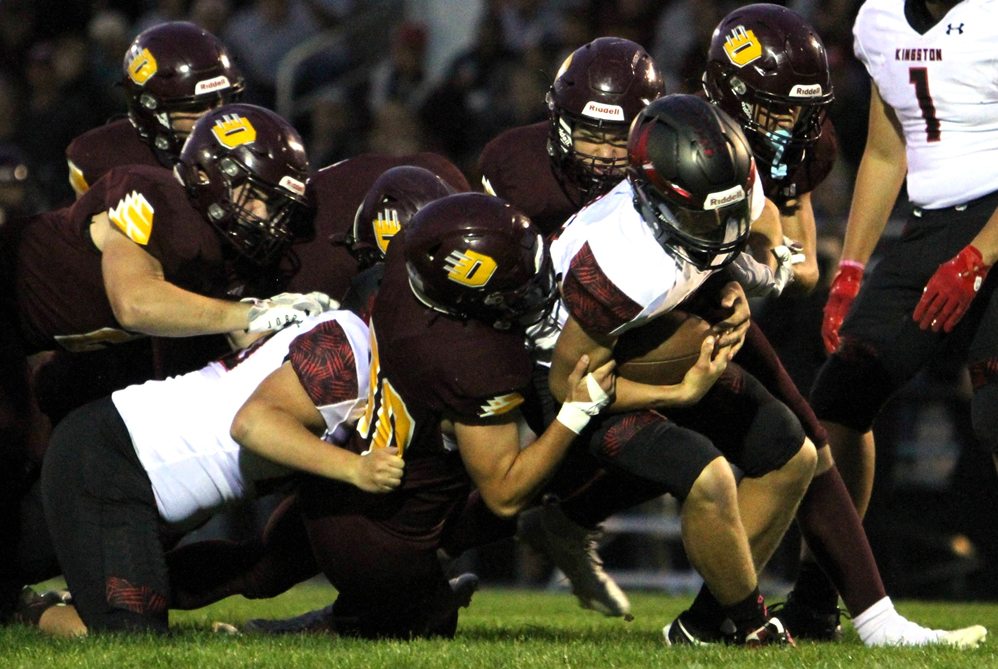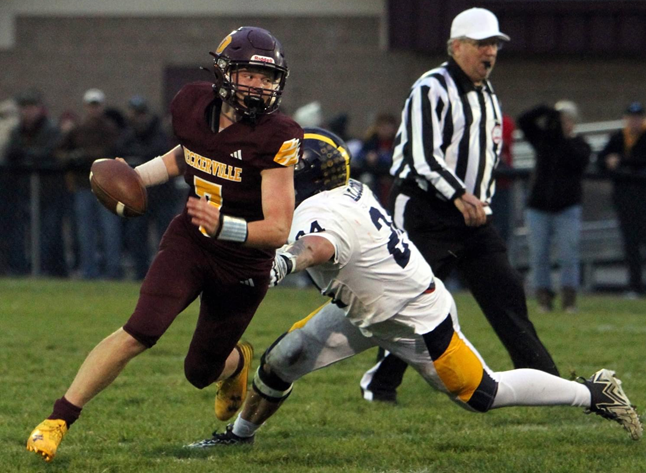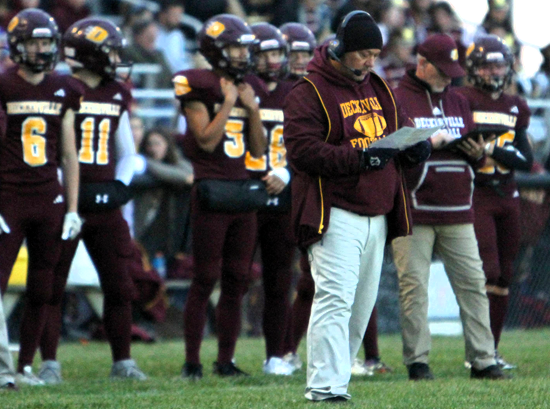
NFHS Voice: Campaign Touts Benefits of High School Football
By
Karissa Niehoff
NFHS Executive Director
May 21, 2021
A full return to high school sports and performing arts programs – that’s the hope for this fall in schools across the country.
After a year of unprecedented challenges in keeping these programs going due to the pandemic, which included 11 states that conducted their primary football season this spring, there is great optimism as we look to a new school year.
Even in those states that were able to conduct activities last fall, attendance restrictions kept many fans out of stadiums and watching games online. However, with vaccine eligibility now at 12 years of age and older and with vaccinations continuing during the next three months, the likelihood of routines and traditions returning this fall grows stronger each day.
And there is no tradition more anticipated than the full-scale return of high school football. While there were 34 states there were fortunate enough to conduct football at some level last fall, the routines were anything but normal.
This fall, however, we anticipate a return to the energy and excitement of the 2019 season when 1,003,524 boys participated in 11-player football. That total marked a decline of only 2,489 from the previous year and was a good sign of a renewed confidence on the part of parents and student-athletes that concerns about the risk of injury were being addressed.
While boys participation in 11-player football has exceeded one million participants every year since 1999 and is overwhelmingly the most popular boys sport, there have been concerns about declines in past years.
Last fall, the NFHS and the National Football League announced a partnership to promote the growth, understanding and support for football at the high school level. The NFHS and NFL have been studying participation trends, developing educational tools and striving to restore confidence in students and parents that the sport is, in fact, more focused on risk minimization than ever before.
As a result, the springboard to the return of high school football next fall begins this week with the launch of the #ThisIsHSFootball campaign. Through this effort over the next few months, the NFHS will be reaching out to coaches, students, parents, officials, athletic directors and others with research information, participation trends and data on various risk mitigation efforts that, we believe, continues to make high school football safer than it has ever been.
As a part of this effort, the NFHS produced a video entitled “This is High School Football” designed to detail the benefits of participation in high school football.
As the video states, more so than at any other level of play, parents should feel good about their kids playing high school football.
>Here are some of the many educational and medical safeguards put in place the past 12 years to offer parents a comfort level about the safety standards that are a part of high school football.
► Concussion research and education. All NFHS high school playing rules require a student who is exhibiting signs of a concussion to be removed from the game and not allowed to return until the student has been cleared by a medical professional. Thanks to education and training on the part of students, coaches, trainers, parents and others, research data has shown positive trends in concussion rates. In a recent five-year period, concussion rates during practices dropped from 5.47 to 4.44 concussions per 10,000 athletic exposures.
► Concussion in Sport Course. This free online education course has been available through the NFHS Learning Center since 2010, and millions of individuals have taken the course for a deeper understanding about concussions.
► Concussion Laws. By 2014, every state had adopted state concussion laws that established mandatory protocols, and every state high school association has adopted policies that limit contact during preseason drills and in practices during the season.
► Football equipment. Manufacturers continue to produce higher quality equipment every year, and high school coaches are doing a much better job at teaching and coaching the rules of the game and making attempts to minimize risk of injury for players.
► Emergency Action Plans. Thanks to the NFHS Foundation, a copy of the “Anyone Can Save a Life” emergency action plan originally developed by the Minnesota State High School League was sent to all state high school associations and their high schools, and all schools have access to an AED to help save lives.
► Playing Rules. Risk minimization is a major focus of every NFHS sports rules committee. In football, helmet-to-helmet hits are not allowed.
High school football has been a significant part of schools, towns and communities across America for almost 100 years. The NFHS is committed to making the sport as safe as possible for the millions of kids who will play the sport in the years to come.
Dr. Karissa L. Niehoff is in her third year as executive director of the National Federation of State High School Associations (NFHS) in Indianapolis, Indiana. She is the first female to head the national leadership organization for high school athletics and performing arts activities and the sixth full-time executive director of the NFHS, which celebrated its 100th year of service during the 2018-19 school year. She previously was executive director of the Connecticut Association of Schools-Connecticut Interscholastic Athletic Conference for seven years.

With Seasoned Seniors in Lead, Deckerville Set to Begin Another Title Pursuit
By
Paul Costanzo
Special for MHSAA.com
October 30, 2024
Preston Holman was an eighth grader when his family moved to Deckerville from the west side of the state, but it didn’t take long for him to realize how much football meant to the community.
 “Instantly, it was all clear to me that Deckerville was a powerhouse program around here, and if you’re going to play for them and Coach (Bill) Brown, you needed to be the best version of yourself,” said Holman, now a senior and all-state two-way lineman for the Eagles. “It was really cool. I remember my eighth-grade year, Deckerville lost to Mayville on Homecoming. I remember how upset the players were. I could tell in the atmosphere that Deckerville does not like to lose. But it was really cool to see how the community supported the program.”
“Instantly, it was all clear to me that Deckerville was a powerhouse program around here, and if you’re going to play for them and Coach (Bill) Brown, you needed to be the best version of yourself,” said Holman, now a senior and all-state two-way lineman for the Eagles. “It was really cool. I remember my eighth-grade year, Deckerville lost to Mayville on Homecoming. I remember how upset the players were. I could tell in the atmosphere that Deckerville does not like to lose. But it was really cool to see how the community supported the program.”
Holman and the Eagles have set themselves up to have that support through the 8-Player Division 1 Semifinals, should they keep winning, as the highest-rated team by playoff points in the bracket.
Deckerville, which finished a 9-0 regular season with a win over previous No. 1 Alcona in Week 9, will open the postseason at home Friday night against Bay City All Saints.
“It’s been great,” senior quarterback Hunter Garza said. “We’ve been taking it one game at a time and preparing all season for this, and I think the hard work is showing and paying off. This started three years ago, when we were all sophomores and freshmen, and the hard work is all paying off.”
When Garza and Holman were sophomores, they were part of a core group in that class who were playing key roles on the varsity. That group went 7-4 and won a playoff game in 2022, and Brown was starting to see the potential for something special in the future.
 A run to an 8-Player Division 2 Semifinal the next year proved him right.
A run to an 8-Player Division 2 Semifinal the next year proved him right.
“We have six kids that started when they were sophomores that are now seniors, and last year, our defense was one freshman, three sophomores and four juniors, so our whole defense is back,” Brown said. “So we knew we had a lot of potential there. We knew we had something going on, even back then. We knew when they were sophomores, even though they were pretty young. The next year, we got halfway through the season, and they were juniors that were starting to play like seniors.”
Knowing what he had coming back, and what a Deckerville crowd could bring during a playoff run, Brown set out to build a schedule that could guarantee the Eagles homefield advantage through the first three weeks of the postseason. That meant scheduling All Saints in Week 1 and Alcona in Week 9. Even had the Eagles lost those games, the benefit of playing a tougher schedule would have been a net positive. Of course, they won them, getting the best of both worlds.
“We play some tough competition in our conference,” Brown said. “But to get to 9-0, that’s pretty special.”
The Eagles outscored opponents, on average, 49-14 on their way to the program’s first unbeaten season since 2019, and fifth in Brown’s 32 years as head coach.
“I think we’ve played very good defense,” Brown said. “Last week (a 50-42 win against Alcona) was tough, but we were playing one of the best teams in the state. Sometimes you have to outscore someone. I think, defensively, we match up and are able to defend a lot of people. Then, being able to turn around and Hunter Garza is having a great year at quarterback – he can run, and he can throw – so I think we’re a little more diverse offensively.”
Garza has rushed for 1,134 yards and 21 touchdowns on 104 carries this season, leading an Eagles’ offense that is averaging 304.9 yards per game on the ground. Senior Parker Merriman had added 859 yards and 11 TDs.
 Garza also has thrown for 747 yards and nine touchdowns on just 76 pass attempts.
Garza also has thrown for 747 yards and nine touchdowns on just 76 pass attempts.
Defensively, the Eagles specialize in getting teams out of sync, as they have recorded 42 tackles for loss as a team, led by Holman’s 17. He also has nine sacks, while sophomore Brandon Halowitz leads the team with 83 tackles, including 13 for loss and five sacks.
Being a defensive stalwart is nothing new for the Eagles. When they joined the 8-player ranks in 2012, they brought a smashmouth style to what had been a wide-open division, and won a Finals title. The score of that championship game against Bellaire: 14-12.
They’ve made the postseason in each of the 12 years since, advancing to Finals in 2016 and 2017.
“Our goal each year is to win the state championship,” Brown said. “Maybe those seem like lofty goals for many, but I think you have to do that. And, as it goes, right now we’re peaking at it. Last year, nobody would have thought we were going to make a run and get to the Semifinal. I would say the expectations are high for us, and I think that gives our team the drive to always be better than the team that did it before.”
Managing to chase those goals while remaining grounded in the day-to-day work necessary to reach them can be tough. But with senior leaders like Garza and Holman, Brown is confident his team will stay on the right path.
“Deckerville has such a good winning tradition, that it does put a lot of pressure on us, but Coach always says, ‘Just because you’re Deckerville, you’re not guaranteed to make the playoffs,’” Garza said. “Just because you wear the D, doesn’t mean you’re going to make a run in the playoffs. You gotta go out and work for it. You have to go out and win it.”
 Paul Costanzo served as a sportswriter at The Port Huron Times Herald from 2006-15, including three years as lead sportswriter, and prior to that as sports editor at the Hillsdale Daily News from 2005-06. He can be reached at [email protected] with story ideas for Genesee, Lapeer, St. Clair, Sanilac, Huron, Tuscola, Saginaw, Bay, Arenac, Midland and Gladwin counties.
Paul Costanzo served as a sportswriter at The Port Huron Times Herald from 2006-15, including three years as lead sportswriter, and prior to that as sports editor at the Hillsdale Daily News from 2005-06. He can be reached at [email protected] with story ideas for Genesee, Lapeer, St. Clair, Sanilac, Huron, Tuscola, Saginaw, Bay, Arenac, Midland and Gladwin counties.
PHOTOS (Top) The Deckerville defense converges on a Kingston ball carrier during this season’s 44-0 victory. (Middle) Hunter Garza eludes an Alcona defender last week. (Below) Eagles coach Bill Brown, in headset, checks his chart on the sideline. (Photos by Mike Gallagher/Saranac County News.)

